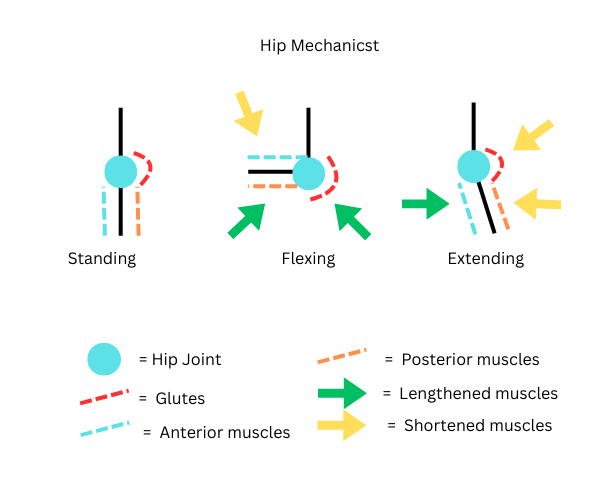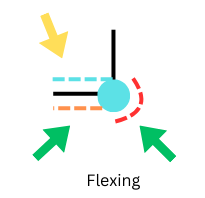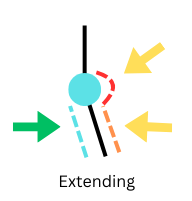Functional Anatomy 101

To start things off, let us get a basic understanding of the musculature that surrounds the hip joint as well as 2 of the basic functions.
Above you can see 3 positions of the hip: standing, flexed, and then extended. For the sake of the article length, we’ll only be touching briefly on the later 2. As well as the two positions of the hip, you can see which muscles will be shorted (Contracted) in that function as well as which muscles will be lengthened (Stretched) during that function.
Not only are the above functions, but other colored lines indicate some very general musculature anatomy around the hip itself. The basic 3 are the anterior leg muscles (Quads), the posterior leg muscles (Hamstrings), and the glutes.
Practical Flexion
 Hip flexion is the act of bringing one’s leg in front of the torso to any degree upwards of 90+.
Hip flexion is the act of bringing one’s leg in front of the torso to any degree upwards of 90+.
You can see from the diagram that when you flex the hip, the glutes (Red) and posterior muscles (Orange) become stretched (Green). On the opposite side, the anterior muscles (Blue) undergo a contraction.
Some of the most common exercises that undergo a degree of hip flexion are squats, lunges, and deadlifts. Often times flexing the hips is a staple in leg training due to the ability to include so many different muscles in one motion.
Practical Extension
 Hip extension is the opposing motion to flexion. It is the act of bringing one’s leg behind the torso to any degree upwards of 45+.
Hip extension is the opposing motion to flexion. It is the act of bringing one’s leg behind the torso to any degree upwards of 45+.
As shown above, you can see the opposite is happening to the musculature compared to hip flexion. Anterior muscles are undergoing a stretch, while the glutes and posterior muscles are contracted.
Some exercises that load our hips in extension are kickbacks of any sort and hyperextensions. Training hips in extension offers a unique stimulus as it trains the glutes and hamstrings in their shortened position. Few exercises offer this.
The Value
After breaking down the very basic ideas of the 2 major hip functions, both flexion and extension, it is important to know why this is valuable.
As a coach, it is part of your job the gain a deeper understanding of the inner workings of exercise and motion. To do this well and effectively, you need a well-rounded understanding of anatomy and function.
Say a client wanted to grow their legs and butt, we just covered 2 major functions of the glutes and leg musculature. Having this kind of knowledge will help expedite client progress and results from a better choice of coach.
Hopefully, these articles and diagrams have been starting to pull back the curtain on musculature function during exercise.
Until next time,
Coach Palfrey



